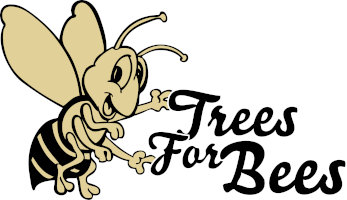
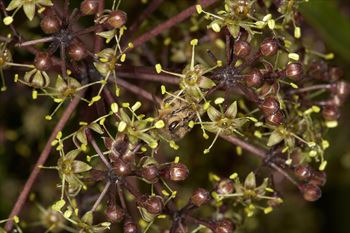
Figure 1. Male flowers of five finger (Pseudopanax arboreus) aggregated in concentrated flowering stalks on the male tree. Photo: Richard Toft © Trees for Bees NZ.
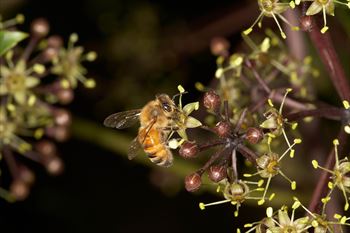
Figure 2. Honeybee collecting pollen from male flower on the male tree of five finger (Pseudopanax arboreus). Male flowers have exposed pollen on five stamens with wide open greenish yellow petals. Photo: Richard Toft © Trees for Bees NZ.
Photographer:Richard Toft
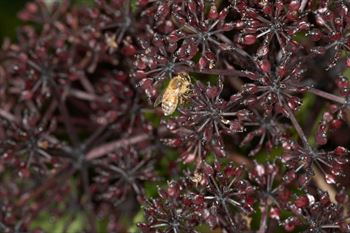
Figure 3. Female flowers of five finger (Pseudopanax arboreus) aggregated into concentrated flowering stalks on the female tree. Photo: Richard Toft © Trees for Bees NZ.
Photographer:Richard Toft
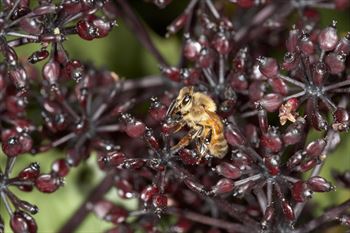
Figure 4. Honeybee taking nectar from female flower on a female tree of five finger (Pseudopanax arboreus). Female flowers have no stamens, petals or sepals. They only have an ovary, a stubby style and a stigma (see red arrows), so they only produce nectar and no pollen. Photo: Richard Toft © Trees for Bees NZ.
Star Performer Status
Five finger is one of our best star performers because the trees provide abundant pollen and copious, rich nectar very early in the season when few other species are in flower (from June to August). In areas where five finger grows well, particularly in the Central North Island, it can even be used to build up bee colonies in early spring. Beekeeper Tony Lorimer reports that honey bees on five finger can swarm in very early spring in years with profuse flowering.
Apiaries need a good number of trees for this rapid build-up, though. Tony says that 200 trees of five finger would be needed as a minimum for 10 hives. In any case, five finger is one of the most important star performer bee plants because it is able to replace gorse for early spring build-up.
Introduction
Five finger’s range is from North Cape to Southland in lowland forests and scrubland from sea level up to 760 m (Marden, Rowan, & Phillips, 2005). But not all areas of New Zealand have the best growing conditions with enough moisture and shelter to generate large trees with plentiful flowers, so it may not be possible to rely on five finger everywhere, particularly if browsing pests are not in control.
Pollen
Pollen
Each tree is either male or female because the flowers are unisexual with only one gendertype per tree. Trees with male flowers deliver both pollen and nectar. The numerous flowers are aggregated into dense flowering stalks called compound umbels (Figure 1). Male flowers have the classic easy access ‘open dish’ structure, with five petals that spread out to expose five stamens and the anthers loaded with pollen (Figure 2). The tightly aggregated flowers provide convenient landing platforms for bees to manoeuvre from flower to flower when collecting pollen. The abundance of flowers on each tree makes up for the small size of the anthers, so a good quantity of pollen is available per tree. Pollen protein levels are good; for example, our pollen sample had 21% crude protein.
Nectar
Nectar Female trees also have densely aggregated flowers in compound umbels (Figure 3). Each female flower produces only nectar and no pollen, as there are no stamens. The female flower structure is peculiar because there are no petals or sepals either. The flower is just a stalk with a flattened round ovary bearing a stubby style and branched stigma—that’s all. The enlarged foot of the style is called a stylopodium and it is here that copious nectar is secreted. When the nectar is flowing, the flower looks like a candy apple dripping with sugar syrup (Figure 4, opposite page).
This exposed nectar gives easy access for all insects and also for nectar-loving birds. The compact aggregation of so many flowers drenched with nectar allows rapid processing of each flower (a matter of seconds) by insects or birds. Remarkably, the energetic value of the nectar (i.e., the total amount of sugar available) from so many tiny flowers is high enough to meet the energy requirements of birds in the size range of large native birds like tui and bellbird (Castro & Robertson, 1997).
Planting Advice
Planting advice Five finger is a small tree (8 m when mature) that has distinctive palmate leaves, with usually five leaflets radiating from a central stalk. It prefers fertile and humus-rich soil on moist sites, but will tolerate drier sites, and requires fertiliser if the topsoil is poor (Marden et al., 2005).
As a secondary succession species, it tolerates moderate frosts and will also tolerate coastal conditions, but should be sheltered from strong winds as it is subject to breakage and is shallow-rooted.
Five finger is suited for low shelter or group plantings as part of a species mix or pure stands. It should be planted in good numbers clustered together to amplify availability of flowers for bee feed. Spacing between plants should be 4–5 m to allow the trees to grow to a good size and maximise flowering. Because it is a preferred forage for possums, goats and deer, protecting the seedlings when planted is important (e.g., use of tree guards), as is maintaining control of these pests long term.
What did Walsh (1967) 1978 say?
Five Finger (Pseudopanax arboreus).
Known to the Maori as Whauhau, five finger is a small tree growing in abundance at the fringe of bush areasthroughout New Zealand. The leaflets are tough, roughly toothed, in clusters of five, and 10 cm to 15 cm long.
The flowers are fragrant, green,borne in terminal umbels, and bloom from July until the end of September.
This plant is a reliable source of spring nectar, sometimes yielding prolifically. On one occasion I saw a number of hives treated for disease, having only foundation, build comb and store a surplus of honey from this source.
The honey is in the top light amber class, but the flavour is marked by a bitter oily after-taste.
Lancewood (Pseudopanax crassifolius).
Also known as Horoeka, a large spreading tree 6 m to 20 m in height. The juvenile leavesare long, thin and deflexed. The adult leaves are much shorter.
The flowers are small and whitish green, produced in loosely arranged terminal umbels. The flowering period is January to April.
Great numbers of bees are observed working the flowers for nectar, in late February; The nectar, pressed from the bees' honey sacs, is light in colour and heavy bodied. Common to both islands.
Quoted from Page 12 and Page 40 in the book Nectar and Pollen Sources of New Zealand by R.S. Walsh first published in 1967 and second edition in 1978 edited by Trevor Walton with assistance from David Williams, Rotorua.
Exotic
False
Native
True
References
References
Castro, I., & Robertson, A. W. (1997). Honeyeaters and the New Zealand forest flora: The utilisation and profitability of small flowers. New Zealand Journal of Ecology, 21(2), 169–179.
Marden, M., Rowan, D., & Phillips, C. (2005). Stabilising characteristics of New Zealand indigenous riparian colonising plants. Plant and Soil, 278(1–2), 95–105.